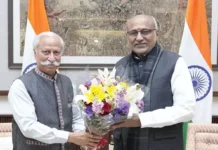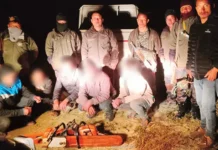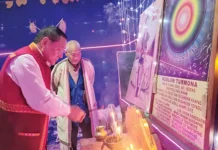[ Yutan Sunya ]
The fundamental justification behind the 70-year-old Naga movement has been the unification of the Nagas residing in Myanmar, Nagaland, and the neighbouring states of Arunachal, Manipur and Assam into a sovereign territory called Greater Nagalim, spreading over 120,000 sq kms. It is based on the belief that all Nagas want to live as one independent country, and that the NSCN and its various factions are fighting on behalf of the ‘Nagas’ for their freedom.
Who are these Nagas? Many tribes residing in the hills of Nagaland, Arunachal, Manipur and some parts of Assam were broadly categorized as ‘Naga tribes’. In February 2019, the Constitution (Scheduled Tribes) Order (Third Amendment) Bill was passed by the government of India, wherein the tribes inhabiting Arunachal’s three districts – Tirap, Changlang and Longding – were recognized as independent tribes and the original suffix, ‘other Naga tribes’, was removed.
While the romance of a freedom struggle gives a moral appeal to the movement, the sentiments of unification for a greater Nagalim is not shared by the tribes living in Arunachal. On the contrary, they strongly identify with Arunachal as their state, and India as their country. The lack of support for unification also rises from the fact that, on the pretext of a freedom struggle, the NSCN and various factions have subjected the people of Tirap, Changlang and Longding districts, who they claim to be their Naga brothers and sisters, to years of torture, extortion and killings. This has not only led to reservations about the real motive behind the movement but also paints a gruesome picture of their future, in case Greater Nagalim were to be formed.
Over the last two decades, there has been a systemic escalation of fear among the people of Tirap, Changlang and Longding districts on account of barbaric acts by the NSCN and various factions, the most recent being the brutal and senseless killing of the sitting MLA of Dadam-Lazu area, Tirong Aboh, and 11 others.
The instances of cruelty inflicted by the Naga insurgent groups on the people residing in these districts are rabid tales of horror. Young boys from the villages were forcefully inducted as cadres of the insurgent groups. Any opposition was met with physical torture of the boys and harassment to the families. Till date, it is mandatory for the villages to shell out money, infamously
known as ‘house tax’, for the sustenance of these cadres.
Additionally, a percentage of money spent on almost every government scheme is collected by these groups from the hapless contractors and departments. Even the salaried are not spared; officials serving in these districts are made to pay a certain amount of their incomes to these groups. It’s difficult to substantiate the amount of these extortions and payments because these are made out of fear. Anyone who speaks out against this corrupt system risks losing their life or limb.
The government of India has deployed a reasonable number of security personnel in the area; however, their acts go unabated. Although the activities and movements of the insurgents have somewhat ebbed, deterred perhaps by the presence of the Indian military, they continue to strike fear among the populace at large. As is often the case in such conflicts, the innocent villager becomes a victim of abuse from the insurgent groups as well as the security forces.
The evolving policy of the government of India in this matter is as much an open secret as are the payments being made to the groups. Despite that, hopes have always been pinned on the government to reach a peaceful solution to the Naga insurgency which has literally sucked the life out of what used to be prosperous districts.
As the Naga peace talks are nearing a conclusion, hope for peace in the region is a welcome feeling, not just for the tribes in Arunachal but for all affected people across Nagaland, Manipur and Assam. Even though the details of the agreement have not been divulged, an end to the armed conflict without redivision of the existing state boundaries would be a good enough outcome. However, the fear remains that, despite the signing of the peace agreement, the activities of these groups will continue to exist. There is also the possibility of renegade factions not honouring the brokered peace agreement. The government might hold its end of the agreement but the breakaway factions might find incentives in continuing with their activities. It has happened in the past, and there is no guarantee that it won’t happen again, unless the final agreement is finely worded to prevent such an eventuality.
The Centre must retain punitive measures to deter potential defaults. The outcome of the final Naga peace agreement becomes so much more important because, over the years, the Naga insurgency has become much more than just a fight for freedom. Use of sophisticated weapons by the cadres of the insurgent groups indicates the involvement of other state actors. To keep the region destabilized and in conflict might be an agenda in the greater scheme of things for entities hostile to India.
Conflicts have never done anyone good, except for parties with vested interests. With the signing of the peace agreement, it’s to be hoped that the Naga movement will finally see its conclusion and peace will prevail over. May we return to being a just society, for “True peace is not merely just absence of tension; it is the presence of justice.” – Martin Luther King, Jr.



